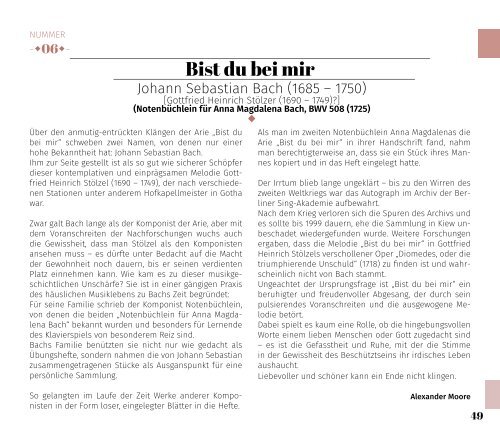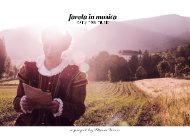Booklet "favola in musica.alte neue musik"
Enjoy the 216 pages fairy tale book inspired booklet of "favola in musica. early new music" in German and English with over 100 photographs, well researched musical texts to each aria, translations of all aria texts in German and English and biographies of all participating members. Music from renaissance, baroque and present time - 3 world premiere recordings from early music (Antonio Caldara, Sebastian Durón) - 2 world premiere recordings of contemporary music (Wolfgang Mitterer) - 1 bonus music-video (included on the CD) Deluxe Edition in a high-quality CD-Hardcover-Digibook, 216 costly designed pages with photos and texts 1607. ensemble for early & new music: Maria Weiss, voice, artistic director Rosario Conte, theorbo Gyöngy Erödi, cello Wolfgang Mitterer, composer Awarded the Pasticciopreis 2015 in Radio Österreich 1 »favola in musica« (eng. fairy tale in music) is the debut-album of the mezzo-soprano Maria Weiss, who designed this album as a musical fairy taie. It is the searching for the New within the Old and for the Old within the New. Developing this album,Maria Weiss lifted some treasures to light, so e.g. she discovered in the archives an aria of the forgotten opera of the composer Antonio Caldara. She also asked the composer and performer Wolfgang Mitterer, to reate two new works for this album. If you engage into this musical journey, you can also find the words of Monteverdis L'Orfeo but in an competely new contemporary way. Enjoy!
Enjoy the 216 pages fairy tale book inspired booklet of "favola in musica. early new music" in German and English with over 100 photographs, well researched musical texts to each aria, translations of all aria texts in German and English and biographies of all participating members.
Music from renaissance, baroque and present time
- 3 world premiere recordings from early music (Antonio Caldara, Sebastian Durón)
- 2 world premiere recordings of contemporary music (Wolfgang Mitterer)
- 1 bonus music-video (included on the CD)
Deluxe Edition in a high-quality CD-Hardcover-Digibook, 216 costly designed pages with photos and texts
1607. ensemble for early & new music:
Maria Weiss, voice, artistic director
Rosario Conte, theorbo
Gyöngy Erödi, cello
Wolfgang Mitterer, composer
Awarded the Pasticciopreis 2015 in Radio Österreich 1
»favola in musica« (eng. fairy tale in music) is the debut-album of the mezzo-soprano Maria Weiss, who designed this album as a musical fairy taie. It is the searching for the New within the Old and for the Old within the New. Developing this album,Maria Weiss lifted some treasures to light, so e.g. she discovered in the archives an aria of the forgotten opera of the composer Antonio Caldara. She also asked the composer and performer Wolfgang Mitterer, to reate two new works for this album. If you engage into this musical journey, you can also find the words of Monteverdis L'Orfeo but in an competely new contemporary way. Enjoy!
Sie wollen auch ein ePaper? Erhöhen Sie die Reichweite Ihrer Titel.
YUMPU macht aus Druck-PDFs automatisch weboptimierte ePaper, die Google liebt.
NUMMER<br />
-•06•-<br />
Über den anmutig-entrückten Klängen der Arie „Bist du<br />
bei mir“ schweben zwei Namen, von denen nur e<strong>in</strong>er<br />
hohe Bekanntheit hat: Johann Sebastian Bach.<br />
Ihm zur Seite gestellt ist als so gut wie sicherer Schöpfer<br />
dieser kontemplativen und e<strong>in</strong>prägsamen Melodie Gottfried<br />
He<strong>in</strong>rich Stölzel (1690 – 1749), der nach verschiedenen<br />
Stationen unter anderem Hofkapellmeister <strong>in</strong> Gotha<br />
war.<br />
Zwar galt Bach lange als der Komponist der Arie, aber mit<br />
dem Voranschreiten der Nachforschungen wuchs auch<br />
die Gewissheit, dass man Stölzel als den Komponisten<br />
ansehen muss – es dürfte unter Bedacht auf die Macht<br />
der Gewohnheit noch dauern, bis er se<strong>in</strong>en verdienten<br />
Platz e<strong>in</strong>nehmen kann. Wie kam es zu dieser musikgeschichtlichen<br />
Unschärfe? Sie ist <strong>in</strong> e<strong>in</strong>er gängigen Praxis<br />
des häuslichen Musiklebens zu Bachs Zeit begründet:<br />
Für se<strong>in</strong>e Familie schrieb der Komponist Notenbüchle<strong>in</strong>,<br />
von denen die beiden „Notenbüchle<strong>in</strong> für Anna Magdalena<br />
Bach“ bekannt wurden und besonders für Lernende<br />
des Klavierspiels von besonderem Reiz s<strong>in</strong>d.<br />
Bachs Familie benützten sie nicht nur wie gedacht als<br />
Übungshefte, sondern nahmen die von Johann Sebastian<br />
zusammengetragenen Stücke als Ausganspunkt für e<strong>in</strong>e<br />
persönliche Sammlung.<br />
Bist du bei mir<br />
Johann Sebastian Bach (1685 – 1750)<br />
[Gottfried He<strong>in</strong>rich Stölzer (1690 – 1749)?]<br />
(Notenbüchle<strong>in</strong> für Anna Magdalena Bach, BWV 508 (1725)<br />
•<br />
Als man im zweiten Notenbüchle<strong>in</strong> Anna Magdalenas die<br />
Arie „Bist du bei mir“ <strong>in</strong> ihrer Handschrift fand, nahm<br />
man berechtigterweise an, dass sie e<strong>in</strong> Stück ihres Mannes<br />
kopiert und <strong>in</strong> das Heft e<strong>in</strong>gelegt hatte.<br />
Der Irrtum blieb lange ungeklärt – bis zu den Wirren des<br />
zweiten Weltkriegs war das Autograph im Archiv der Berl<strong>in</strong>er<br />
S<strong>in</strong>g-Akademie aufbewahrt.<br />
Nach dem Krieg verloren sich die Spuren des Archivs und<br />
es sollte bis 1999 dauern, ehe die Sammlung <strong>in</strong> Kiew unbeschadet<br />
wiedergefunden wurde. Weitere Forschungen<br />
ergaben, dass die Melodie „Bist du bei mir“ <strong>in</strong> Gottfried<br />
He<strong>in</strong>rich Stölzels verschollener Oper „Diomedes, oder die<br />
triumphierende Unschuld“ (1718) zu f<strong>in</strong>den ist und wahrsche<strong>in</strong>lich<br />
nicht von Bach stammt.<br />
Ungeachtet der Ursprungsfrage ist „Bist du bei mir“ e<strong>in</strong><br />
beruhigter und freudenvoller Abgesang, der durch se<strong>in</strong><br />
pulsierendes Voranschreiten und die ausgewogene Melodie<br />
betört.<br />
Dabei spielt es kaum e<strong>in</strong>e Rolle, ob die h<strong>in</strong>gebungsvollen<br />
Worte e<strong>in</strong>em lieben Menschen oder Gott zugedacht s<strong>in</strong>d<br />
– es ist die Gefasstheit und Ruhe, mit der die Stimme<br />
<strong>in</strong> der Gewissheit des Beschütztse<strong>in</strong>s ihr irdisches Leben<br />
aushaucht.<br />
Liebevoller und schöner kann e<strong>in</strong> Ende nicht kl<strong>in</strong>gen.<br />
So gelangten im Laufe der Zeit Werke anderer Komponisten<br />
<strong>in</strong> der Form loser, e<strong>in</strong>gelegter Blätter <strong>in</strong> die Hefte.<br />
Alexander Moore<br />
49





